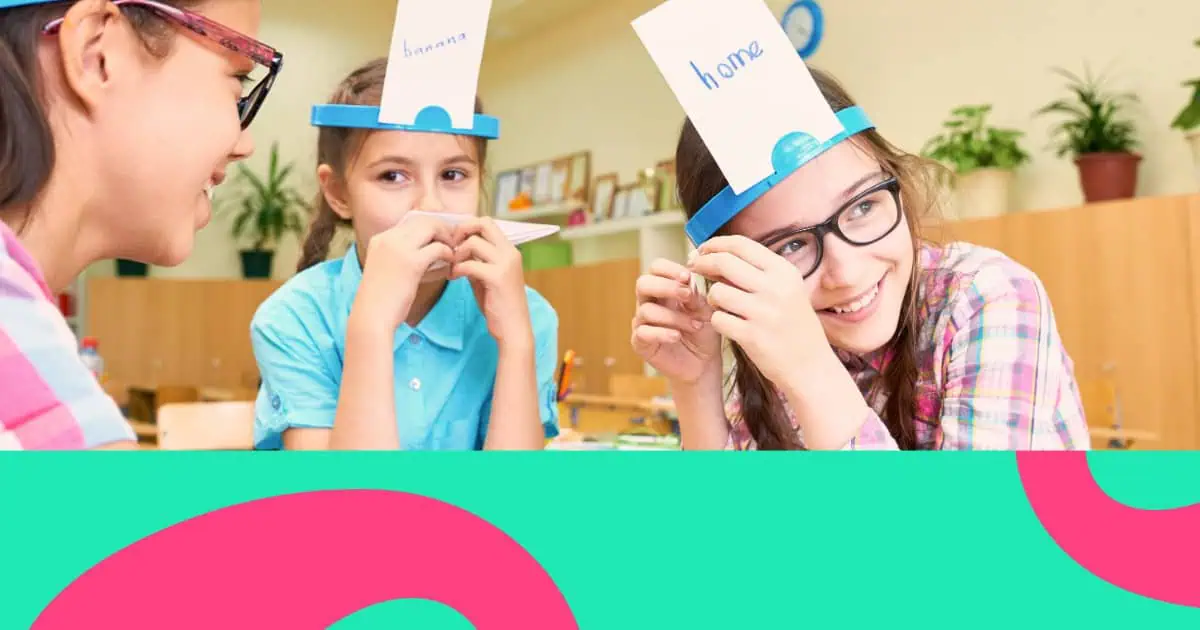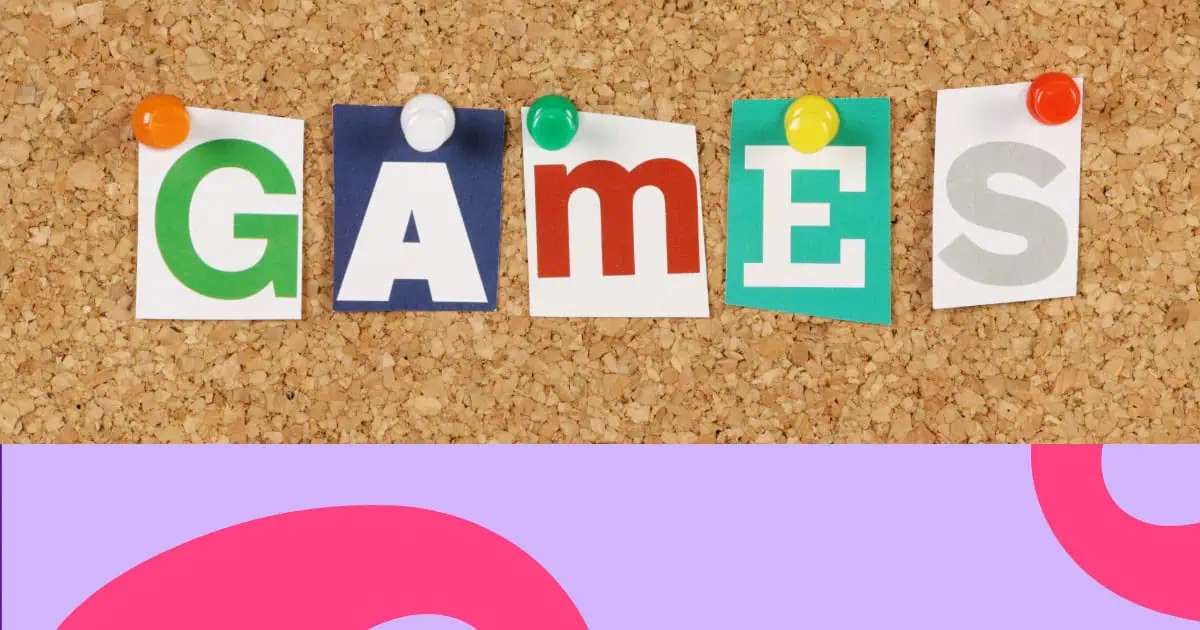चाहे तपाईं घरबाट सिक्दै हुनुहुन्छ वा कक्षाकोठामा फर्किनु भएको छ, फेस-टू-फेस पुन: जडान गर्दा सुरुमा अप्ठ्यारो महसुस हुन सक्छ।
सौभाग्यवश, हामीले २१ सुपर रमाइलो पाएका छौं विद्यार्थीहरूको लागि आइसब्रेकर खेलहरू र ती मित्रताको बन्धनलाई फेरि एक पटक खुकुलो पार्न र बलियो बनाउनको लागि तयारी बिनाका सजिलो गतिविधिहरू।
कसलाई थाहा छ, विद्यार्थीहरूले प्रक्रियामा नयाँ BFF वा दुई पत्ता लगाउन सक्छन्। र के स्कूल भनेको सबैको बारेमा होइन - सम्झनाहरू, भित्री मजाकहरू, र चिरस्थायी मित्रतालाई फर्केर हेर्नको लागि?
विद्यार्थीको संलग्नतालाई बलियो बनाउन र सिकाइमा उनीहरूको रुचि जगाउन, विद्यार्थीहरूको लागि रमाइलो आइस-ब्रेक गतिविधिहरूसँग कक्षाहरू मिलाउन आवश्यक छ। यी केही रोमाञ्चक गुच्छा जाँच गर्नुहोस्:
प्राथमिक विद्यालयका आइसब्रेकरहरू (५-१० वर्ष उमेरका)
🟢 शुरुआती स्तर (५-१० वर्ष उमेर)
१. तस्बिरहरू अनुमान गर्नुहोस्
उद्देश्य: अवलोकन कौशल र शब्दावली विकास गर्नुहोस्
कसरी खेल्ने:
- तपाईंको पाठको विषयसँग सम्बन्धित चित्रहरू छान्नुहोस्।
- जुम इन गर्नुहोस् र रचनात्मक रूपमा क्रप गर्नुहोस्
- एक पटकमा एउटा तस्वीर प्रदर्शन गर्नुहोस्
- विद्यार्थीहरूले चित्रले के देखाउँछ भनेर अनुमान लगाउँछन्
- पहिलो सही अनुमानले अंक जित्छ
AhaSlides एकीकरण: विद्यार्थीहरूलाई आफ्ना उपकरणहरू मार्फत उत्तरहरू पेश गर्न अनुमति दिँदै छविहरू सहितको अन्तरक्रियात्मक क्विज स्लाइडहरू सिर्जना गर्नुहोस्। वास्तविक-समय परिणामहरू स्क्रिनमा देखिन्छन्।
। प्रो टिप: बिस्तारै तस्वीरको थप भाग देखाउन, सस्पेन्स र संलग्नता निर्माण गर्न AhaSlides को छवि प्रकट गर्ने सुविधा प्रयोग गर्नुहोस्।
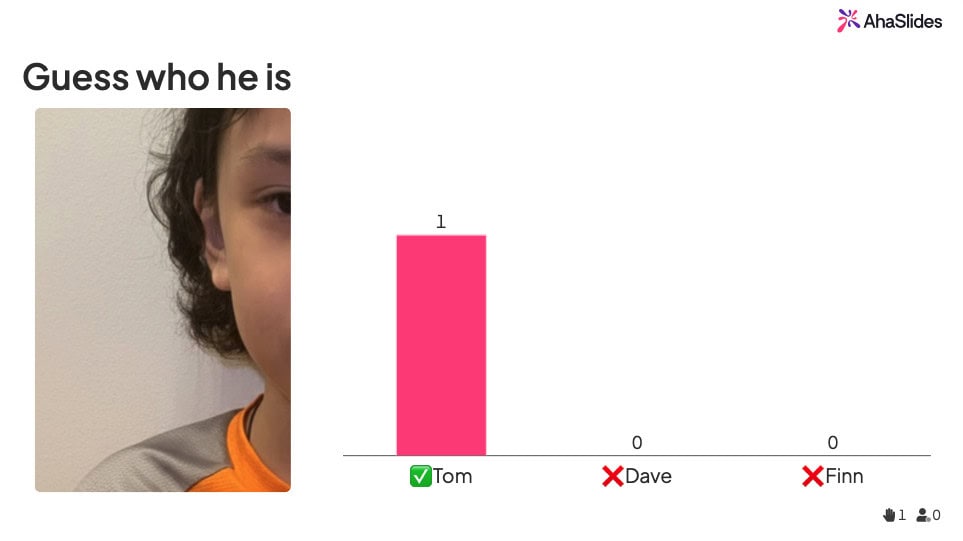
२. इमोजी क्यारेडहरू
उद्देश्य: रचनात्मकता र गैर-मौखिक संचार बढाउनुहोस्
कसरी खेल्ने:
- थप प्रतिस्पर्धाको लागि टोलीहरूमा खेल्नुहोस्
- फरक अर्थ भएका इमोजीहरूको सूची बनाउनुहोस्
- एउटा विद्यार्थीले इमोजी छान्छ र त्यसलाई अभिनय गर्छ
- सहपाठीहरूले इमोजी अनुमान गर्छन्
- पहिलो सही अनुमानले अङ्क कमाउँछ
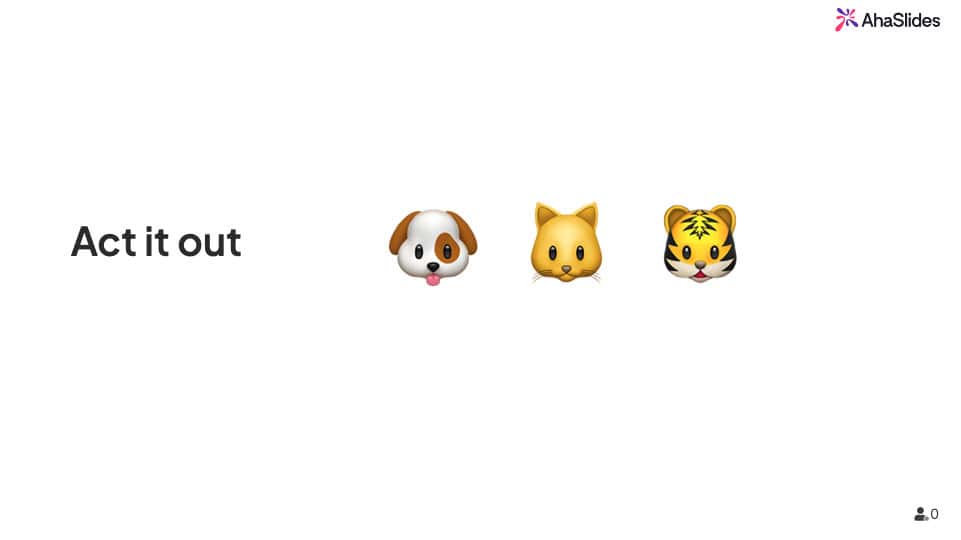
३. साइमन भन्छन्
उद्देश्य: सुन्ने सीप सुधार गर्नुहोस् र निर्देशनहरू पालना गर्नुहोस्
कसरी खेल्ने:
- शिक्षक नै नेता हुन् (साइमन)
- "साइमन भन्छन्" को उपसर्ग लगाइएमा मात्र विद्यार्थीहरूले आदेशहरू पालना गर्छन्।
- "साइमन भन्छन्" बिना आदेश पालना गर्ने विद्यार्थीहरू बाहिरिन्छन्।
- अन्तिम पटक उभिएका विद्यार्थीको जित
🟡 मध्यवर्ती स्तर (८-१० वर्ष उमेर)
४. २० प्रश्नहरू
उद्देश्य: आलोचनात्मक सोच र प्रश्न गर्ने सीप विकास गर्नुहोस्
कसरी खेल्ने:
- कक्षालाई टोलीमा विभाजन गर्नुहोस्
- टोली नेताले कुनै व्यक्ति, ठाउँ वा चीजको बारेमा सोच्दछ
- टोलीलाई अनुमान गर्न २० वटा "हुन्छ/हुन्न" प्रश्नहरू दिइन्छ।
- २० प्रश्न भित्र सही अनुमान = टोली जित्छ
- नत्र, नेताले जित्छ
P. शब्दकोष
उद्देश्य: रचनात्मकता र दृश्य संचार बढाउनुहोस्
कसरी खेल्ने:
- ड्रावासोरस जस्तो अनलाइन रेखाचित्र प्लेटफर्म प्रयोग गर्नुहोस्
- १६ जनासम्म विद्यार्थीहरूको लागि निजी कोठा सिर्जना गर्नुहोस्
- एउटा विद्यार्थीले चित्र कोर्छ, अरूले अनुमान गर्छन्
- प्रति ड्र तीन मौका
- सबैभन्दा धेरै सही अनुमान लगाउने टोलीले जित्छ
६. म जासुसी गर्छु
उद्देश्य: अवलोकन कौशल र विवरणमा ध्यान सुधार गर्नुहोस्
कसरी खेल्ने:
- विद्यार्थीहरूले वस्तुहरूको वर्णन गर्दै पालैपालो लिन्छन्
- विशेषण प्रयोग गर्नुहोस्: "म शिक्षकको टेबलमा रातो केही देख्छु"
- अर्को विद्यार्थीले वस्तु अनुमान गर्छ
- सही अनुमान अर्को जासूस हुनेछ।
माध्यमिक विद्यालयका आइसब्रेकरहरू (११-१४ वर्ष उमेरका)
🟡 मध्यवर्ती स्तर (८-१० वर्ष उमेर)
7. शीर्ष 5
उद्देश्य: सहभागितालाई प्रोत्साहन गर्नुहोस् र साझा रुचिहरू पत्ता लगाउनुहोस्
कसरी खेल्ने:
- विद्यार्थीहरूलाई एउटा विषय दिनुहोस् (जस्तै, "विश्रामको लागि शीर्ष ५ खाजा")
- विद्यार्थीहरूले लाइभ वर्ड क्लाउडमा आफ्ना छनोटहरू सूचीबद्ध गर्छन्।
- सबैभन्दा लोकप्रिय प्रविष्टिहरू सबैभन्दा ठूला देखिन्छन्
- #१ अनुमान गर्ने विद्यार्थीहरूले ५ अङ्क पाउँछन्
- लोकप्रियताको श्रेणीकरणसँगै अंक घट्छ
। प्रो टिप: विद्यार्थी प्रतिक्रियाहरूको वास्तविक-समय दृश्यावलोकन सिर्जना गर्न क्लाउड शब्द सुविधा प्रयोग गर्नुहोस्, जसको आकारले लोकप्रियता जनाउँछ। AhaSlides को वर्ड क्लाउड वास्तविक समयमा अपडेट हुन्छ, जसले वर्ग प्राथमिकताहरूको आकर्षक दृश्य प्रतिनिधित्व सिर्जना गर्दछ।
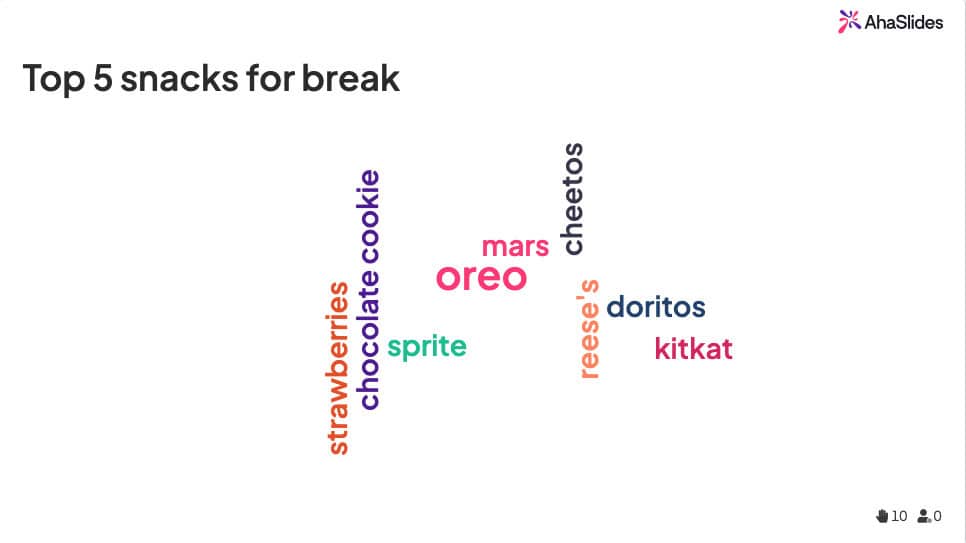
८. विश्व झण्डा क्विज
उद्देश्य: सांस्कृतिक जागरूकता र भूगोल ज्ञान निर्माण गर्नुहोस्
कसरी खेल्ने:
- कक्षालाई टोलीमा विभाजन गर्नुहोस्
- विभिन्न देशका झण्डाहरू प्रदर्शन गर्नुहोस्
- टोलीहरूले देशहरूको नाम राख्छन्
- प्रति टोली तीन प्रश्नहरू
- सबैभन्दा धेरै सही उत्तर दिने टोलीले जित्छ
AhaSlides एकीकरण: प्रयोग गर्नुहोस् प्रश्नोत्तरी सुविधा बहुविकल्पीय विकल्पहरूको साथ अन्तरक्रियात्मक झण्डा पहिचान खेलहरू सिर्जना गर्न।
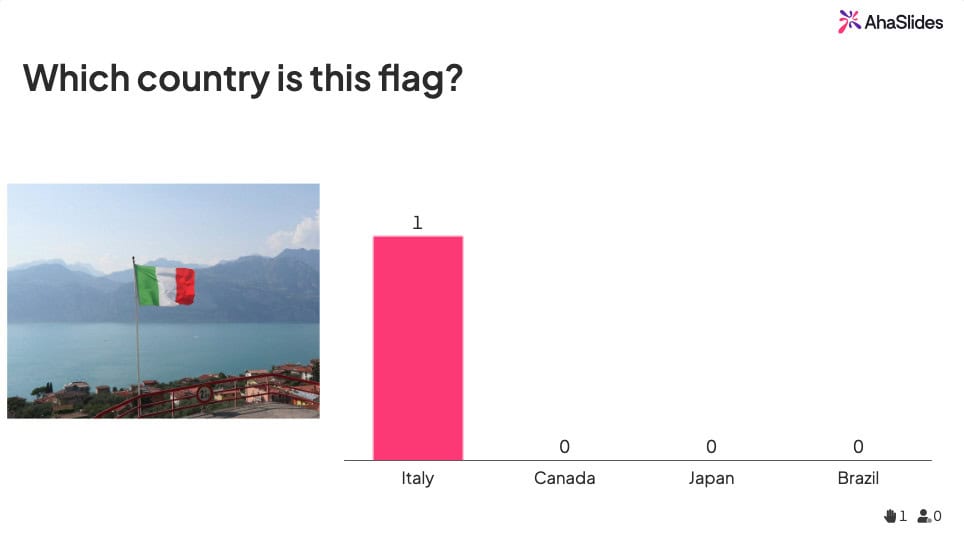
९. आवाज अनुमान गर्नुहोस्
उद्देश्य: श्रवण कौशल र सांस्कृतिक जागरूकता विकास गर्नुहोस्
कसरी खेल्ने:
- रुचिको विषय छान्नुहोस् (कार्टुन, गीत, प्रकृति)
- ध्वनि क्लिपहरू प्ले गर्नुहोस्
- विद्यार्थीहरूले ध्वनिले के प्रतिनिधित्व गर्छ भनेर अनुमान लगाउँछन्
- छलफलको लागि उत्तरहरू रेकर्ड गर्नुहोस्
- उत्तरहरूको पछाडिको तर्कको बारेमा छलफल गर्नुहोस्
🟠 उन्नत स्तर (१३-१४ वर्ष उमेर)
१०. सप्ताहन्त ट्रिभिया
उद्देश्य: समुदाय निर्माण गर्नुहोस् र अनुभवहरू साझा गर्नुहोस्
कसरी खेल्ने:
- सप्ताहन्त ट्रिभिया सोमबार ब्लुजलाई हराउनको लागि उपयुक्त छ र हाई स्कूलका विद्यार्थीहरूलाई उनीहरू के गरिसकेका छन् भनी जान्नको लागि उत्कृष्ट कक्षाकोठा आइसब्रेकर। जस्तै नि: शुल्क अन्तरक्रियात्मक प्रस्तुतीकरण उपकरण प्रयोग गर्दै एहास्लाइड्स, तपाईं खुला सत्र आयोजना गर्न सक्नुहुन्छ जहाँ विद्यार्थीहरूले शब्द सीमा बिना प्रश्नको उत्तर दिन सक्छन्।
- त्यसपछि विद्यार्थीहरूलाई सप्ताहन्तमा कसले के गर्यो अनुमान गर्न सोध्नुहोस्।
- विद्यार्थीहरूलाई सोध्नुहोस् कि उनीहरूले सप्ताहन्तमा के गरे।
- तपाइँ एक समय सीमा सेट गर्न सक्नुहुन्छ र सबैले आफ्नो पेश गरेपछि जवाफहरू प्रदर्शन गर्न सक्नुहुन्छ।
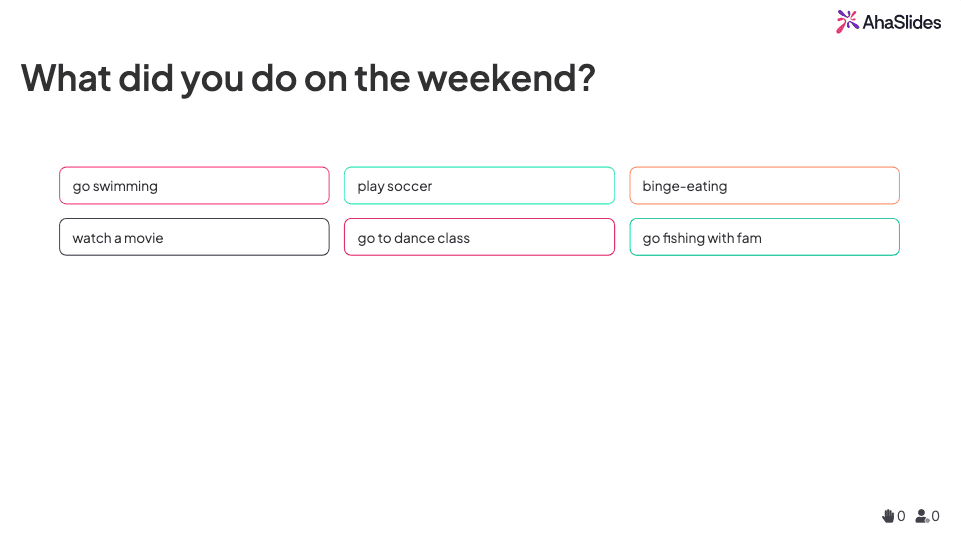
Py. पिरामिड
उद्देश्य: शब्दावली र सहयोगी सोच विकास गर्नुहोस्
कसरी खेल्ने:
- सम्बन्ध र सम्बन्धहरूको बारेमा छलफल गर्नुहोस्
- अनियमित शब्द प्रदर्शन गर्नुहोस् (जस्तै, "संग्रहालय")
- टोलीहरूले ६ सम्बन्धित शब्दहरूको मंथन गर्छन्
- शब्दहरू मुख्य शब्दसँग जोडिएको हुनुपर्छ
- धेरै शब्दहरू भएको टोलीले जित्छ
२. माफिया
उद्देश्य: आलोचनात्मक सोच र सामाजिक सीपहरू विकास गर्नुहोस्
कसरी खेल्ने:
- गोप्य भूमिका तोक्नुहोस् (माफिया, जासूस, नागरिक)
- दिन र रात चरणहरूसँग राउन्डमा खेल्नुहोस्
- माफियाले रातमा खेलाडीहरूलाई हटाउँछन्
- नागरिकहरूले दिनभरि शंकास्पदहरूलाई हटाउन मतदान गर्छन्
- नागरिकभन्दा बढी संख्या भएमा माफियाले जित्छ
हाई स्कूल आइसब्रेकरहरू (१५-१८ वर्ष उमेरका)
🔴 उन्नत स्तर (१५-१८ वर्ष उमेर)
१३. अनौठो एउटा
उद्देश्य: विश्लेषणात्मक सोच र तर्क कौशल विकास गर्नुहोस्
कसरी खेल्ने:
- ४-५ वस्तुहरूको समूह प्रस्तुत गर्नुहोस्
- विद्यार्थीहरूले अनौठोलाई पहिचान गर्छन्
- छनौटको पछाडिको कारण व्याख्या गर्नुहोस्
- विभिन्न दृष्टिकोणहरू छलफल गर्नुहोस्
- रचनात्मक सोचलाई प्रोत्साहन गर्नुहोस्
14। मेमोरी
उद्देश्य: मेमोरी सीप र विवरणमा ध्यान सुधार गर्नुहोस्
कसरी खेल्ने:
- धेरै वस्तुहरू भएको छवि प्रदर्शन गर्नुहोस्
- सम्झन २०-६० सेकेन्ड दिनुहोस्।
- छवि हटाउनुहोस्
- विद्यार्थीहरूले सम्झिएका वस्तुहरूको सूची बनाउँछन्
- सबैभन्दा सटीक सूची जीतहरू
AhaSlides एकीकरण: वस्तुहरू देखाउन छवि प्रकट गर्ने सुविधा प्रयोग गर्नुहोस्, र सम्झिएका सबै वस्तुहरू सङ्कलन गर्न क्लाउड शब्द प्रयोग गर्नुहोस्।
१५. ब्याज सूची
उद्देश्य: सम्बन्ध निर्माण गर्नुहोस् र साझा रुचिहरू पत्ता लगाउनुहोस्
कसरी खेल्ने:
- विद्यार्थीहरूले रुचि कार्यपत्र पूरा गर्छन्
- सोख, चलचित्र, ठाउँ, चीजहरू समावेश गर्नुहोस्
- शिक्षकले प्रति दिन एउटा कार्यपत्र प्रदर्शन गर्नुहुन्छ
- वर्गले अनुमान गर्छ कि यो कसको हो
- साझा रुचिहरू प्रकट गर्नुहोस् र छलफल गर्नुहोस्
१६. यसलाई पाँचमा हिर्काउनुहोस्
उद्देश्य: द्रुत सोच र वर्ग ज्ञान विकास गर्नुहोस्
कसरी खेल्ने:
- श्रेणी (कीरा, फलफूल, देश) छान्नुहोस्
- विद्यार्थीहरूले ५ सेकेन्डमा ३ वटा वस्तुको नाम राख्छन्
- व्यक्तिगत रूपमा वा समूहहरूमा खेल्नुहोस्
- सही उत्तरहरू ट्र्याक गर्नुहोस्
- सबैभन्दा सही जितहरू
Py. पिरामिड
उद्देश्य: शब्दावली र सहयोगी सोच विकास गर्नुहोस्
कसरी खेल्ने:
- अनियमित शब्द प्रदर्शन गर्नुहोस् (जस्तै, "संग्रहालय")
- टोलीहरूले ६ सम्बन्धित शब्दहरूको मंथन गर्छन्
- शब्दहरू मुख्य शब्दसँग जोडिएको हुनुपर्छ
- धेरै शब्दहरू भएको टोलीले जित्छ
- सम्बन्ध र सम्बन्धहरूको बारेमा छलफल गर्नुहोस्
१८. म पनि
उद्देश्य: सम्बन्ध निर्माण गर्नुहोस् र समानताहरू पत्ता लगाउनुहोस्
कसरी खेल्ने:
- विद्यार्थीले व्यक्तिगत कथन साझा गर्छन्
- सम्बन्धित अरूले "म पनि" भन्छन्।
- साझा रुचिमा आधारित समूहहरू बनाउनुहोस्
- फरक कथनहरू जारी राख्नुहोस्
- भविष्यका गतिविधिहरूको लागि समूहहरू प्रयोग गर्नुहोस्
AhaSlides एकीकरण: "म पनि" प्रतिक्रियाहरू सङ्कलन गर्न क्लाउड सुविधा शब्द प्रयोग गर्नुहोस्, र रुचि अनुसार विद्यार्थीहरूलाई व्यवस्थित गर्न समूहबद्ध सुविधा प्रयोग गर्नुहोस्।
भर्चुअल सिकाइ आइसब्रेकरहरू
💻 प्रविधि-उन्नत गतिविधिहरू
१९. भर्चुअल स्क्याभेन्जर हन्ट
उद्देश्य: विद्यार्थीहरूलाई भर्चुअल वातावरणमा संलग्न गराउनुहोस्
कसरी खेल्ने:
- घरमा पाइने वस्तुहरूको सूची बनाउनुहोस्
- विद्यार्थीहरूले क्यामेरामा वस्तुहरू खोज्छन् र देखाउँछन्
- सबै वस्तुहरू फेला पार्ने पहिलो व्यक्ति जित्छ
- रचनात्मकता र साधनसम्पन्नतालाई प्रोत्साहन गर्नुहोस्
- निष्कर्ष र अनुभवहरू छलफल गर्नुहोस्
२०. एक-शब्द चेक-इन
उद्देश्य: कक्षा अघि र पछि भावनाहरू नाप्न र बरफ तोड्ने उपकरणको रूपमा प्रयोग गरिन्छ।
कसरी खेल्ने:
- विद्यार्थीहरूले अनुकूलित भर्चुअल पृष्ठभूमिहरू सिर्जना गर्छन्
- कक्षासँग पृष्ठभूमिहरू साझा गर्नुहोस्
- सबैभन्दा रचनात्मक डिजाइनमा मतदान गर्नुहोस्
- भविष्यका सत्रहरूको लागि पृष्ठभूमिहरू प्रयोग गर्नुहोस्
AhaSlides एकीकरण: पृष्ठभूमि डिजाइनहरू प्रदर्शन गर्न छवि सुविधा प्रयोग गर्नुहोस्, र विजेताहरू चयन गर्न मतदान सुविधा प्रयोग गर्नुहोस्।
अधिकतम संलग्नताको लागि विशेषज्ञ सुझावहरू
🧠 मनोविज्ञानमा आधारित संलग्नता रणनीतिहरू
- कम जोखिम गतिविधिहरु संग सुरु गर्नुहोस्: आत्मविश्वास निर्माण गर्न सरल, गैर-धम्कीपूर्ण खेलहरूबाट सुरु गर्नुहोस्
- सकारात्मक सुदृढीकरण प्रयोग गर्नुहोस्: सही उत्तर मात्र नभई सहभागिता मनाउनुहोस्
- सुरक्षित ठाउँहरू सिर्जना गर्नुहोस्: सबै विद्यार्थीहरूले सहभागी हुन सहज महसुस गरून् भन्ने कुरा सुनिश्चित गर्नुहोस्
- ढाँचा फरक पार्नुहोस्: व्यक्तिगत, जोडी र समूह गतिविधिहरू मिलाउनुहोस्
🎯 साझा चुनौती र समाधानहरू
- लजालु विद्यार्थीहरू: बेनामी मतदान वा सानो समूह गतिविधिहरू प्रयोग गर्नुहोस्
- ठूला कक्षाहरू: साना समूहहरूमा विभाजन गर्नुहोस् वा प्रविधि उपकरणहरू प्रयोग गर्नुहोस्
- समय बाधाहरू: ५-मिनेटका द्रुत गतिविधिहरू छनौट गर्नुहोस्
- भर्चुअल सेटिङहरू: संलग्नताको लागि AhaSlides जस्ता अन्तरक्रियात्मक प्लेटफर्महरू प्रयोग गर्नुहोस्
📚 अनुसन्धान-समर्थित लाभहरू
अनुसन्धानका अनुसार, सही तरिकाले लागू गर्दा विद्यार्थीहरूको लागि आइसब्रेकरहरूको धेरै फाइदा हुन सक्छ:
- बढ्दो सहभागिता
- कम चिन्ता
- राम्रो सम्बन्ध
- परिष्कृत सिकाइ
(स्रोत: चिकित्सा शिक्षा)
कुञ्जी टेकवेहरू
विद्यार्थीहरूका लागि आइसब्रेकर खेलहरू प्रारम्भिक बरफ तोड्ने र वार्तालापलाई आमन्त्रित गर्नेभन्दा बाहिर जान्छन्, तिनीहरूले शिक्षक र विद्यार्थीहरू बीच एकता र खुलापनको संस्कृतिलाई बढावा दिन्छ। कक्षाकोठामा अन्तरक्रियात्मक खेलहरू बारम्बार एकीकृत गर्दा धेरै फाइदाहरू साबित भएका छन्, त्यसैले केही रमाइलो गर्न नहिचकिचाउनुहोस्!
तयारी नगरी खेलहरू र गतिविधिहरू खेल्न धेरै प्लेटफर्महरू खोज्नु चुनौतीपूर्ण हुन सक्छ, विशेष गरी जब तपाईंसँग कक्षाको लागि धेरै तयारी गर्न हुन्छ। AhaSlides ले अन्तरक्रियात्मक प्रस्तुतीकरण विकल्पहरूको विस्तृत श्रृंखला प्रदान गर्दछ जुन शिक्षक र विद्यार्थीहरू दुवैको लागि रमाइलो छ।
प्राय : सोधिने प्रश्नहरू
विभिन्न उमेर समूहका लागि आइसब्रेकरहरू कसरी अनुकूलन गर्ने?
साना विद्यार्थीहरू (५-७ वर्षका) का लागि, स्पष्ट निर्देशनहरू सहित सरल, दृश्य गतिविधिहरूमा ध्यान केन्द्रित गर्नुहोस्। माध्यमिक विद्यालयका विद्यार्थीहरू (११-१४ वर्षका) का लागि, प्रविधि र सामाजिक तत्वहरू समावेश गर्नुहोस्। उच्च माध्यमिक विद्यालयका विद्यार्थीहरू (१५-१८ वर्षका) ले आलोचनात्मक सोचलाई प्रोत्साहन गर्ने थप जटिल, विश्लेषणात्मक गतिविधिहरू ह्यान्डल गर्न सक्छन्।
3 रमाइलो आइसब्रेकर प्रश्नहरू के हुन्?
यहाँ 3 रमाइलो आइसब्रेकर प्रश्नहरू र खेलहरू छन् जुन विद्यार्थीहरूले प्रयोग गर्न सक्छन्:
1. दुई सत्य र एक झूट
यस क्लासिकमा, विद्यार्थीहरूले पालैपालो 2 आफ्नो बारेमा सत्यपूर्ण कथनहरू र 1 झूट बोल्छन्। अरूले अनुमान लगाउनु पर्छ कुन झुटो हो। यो सहपाठीहरूका लागि एक अर्काको बारेमा वास्तविक र नक्कली तथ्यहरू सिक्ने रमाईलो तरिका हो।
२. के तपाई बरु...
विद्यार्थीहरूलाई जोडा बनाउनुहोस् र मूर्ख परिदृश्य वा छनौटको साथ "के तपाई बरु" प्रश्नहरू सोध्नुहोस्। उदाहरणहरू हुन सक्छन्: "के तपाई एक वर्षको लागि सोडा वा जुस मात्र पिउनुहुन्छ?" यो हलुका प्रश्नले व्यक्तित्वलाई चम्काउन दिन्छ।
3. नाममा के छ?
वरिपरि जानुहोस् र प्रत्येक व्यक्तिलाई आफ्नो नाम भन्न लगाउनुहोस्, यदि उनीहरूलाई थाहा छ भने उनीहरूको नामको अर्थ वा उत्पत्ति सहित। यो केवल नाम भन्नु भन्दा बढी रोचक परिचय हो, र यसले मानिसहरूलाई उनीहरूको नाम पछाडिका कथाहरूको बारेमा सोच्न बाध्य पार्छ। भिन्नताहरू उनीहरूले कहिल्यै सुनेका मनपर्ने नाम वा उनीहरूले कल्पना गर्न सक्ने सबैभन्दा लाजमर्दो नाम हुन सक्छ।
राम्रो परिचय गतिविधि के हो?
नाम खेल विद्यार्थीहरूको लागि आफ्नो परिचय दिनको लागि एक उत्कृष्ट गतिविधि हो। तिनीहरू वरिपरि जान्छन् र एउटै अक्षरबाट सुरु हुने विशेषणको साथ आफ्नो नाम भन्छन्। उदाहरणका लागि "जैजी जोन" वा "ह्याप्पी हन्ना।" यो नाम सिक्न एक रमाइलो तरिका हो।
